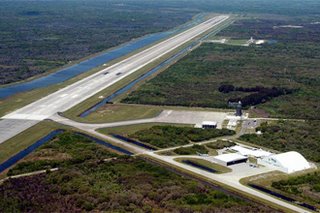Space Shuttle DISCOVERY~LANDING TODAY~9:14 AM~SAFE !!!


UPDATE !!!... HERE SHE COMES.... whoo hoo... SAFE LANDING!! WELCOME HOME GUYS & GIRLS !!
9:13 AM....DISCOVERY IS ON THE WAY IN. LANDING AT KENNEDY SPACE CENTER IN FLORIDA AT 9:14 AM EASTERN STANDARD TIME. DUE TO THE WEATHER THE ONLY CHANGE MADE WAS THE DIRECTION THE SPACE SHUTTLE WILL COME IN AT RUNWAY 15..READ ON BELOW.GOOD LUCK GUYS!!
OVER AND OUT..






Space Shuttle Discovery Cleared to Land
Monday, July 17, 2006
CAPE CANAVERAL, Fla. — Space shuttle Discovery and its crew of six streaked toward Earth on Monday, wrapping up a successful mission that put NASA back in the space-station construction business.
All that remained for NASA to declare total victory, for the first time since before the 2003 Columbia disaster, was a safe landing. Discovery was due to touch down on the Kennedy Space Center runway at 9:14 a.m.
Mission Control waited until almost the last minute before notifying the astronauts that the weather was good enough to come home.
The shuttle, with commander Steven Lindsey and co-pilot Mark Kelly at the controls, plunged out of orbit an hour before touchdown with the firing of the braking rockets, and began the hourlong descent.
The flight path had the spacecraft coming in from the south, swooping over the Pacific, Yucatan Peninsula, Gulf of Mexico and across Florida to cap a 5.3 million-mile journey that began on the Fourth of July.
When Mission Control woke up the astronauts just after 1 a.m. EDT, Lindsey made it clear that his crew, weary after a 13-day mission that he said was the busiest of his four fights, wanted to come.
"Hopefully, with good weather we will be on the ground" later Monday, Lindsey told Mission Control as he woke up.
The Kennedy Space Center in Florida is the only landing site NASA has called up for the day. Astronauts doing reconnaissance weather flights reported no problems, but NASA was keeping an eye on showers to the northeast that were moving toward the landing strip.
This would be the first landing at Kennedy in nearly four years. Last year's flight of Discovery, after weather delays, came down at Edwards Air Force Base in California, the backup site.
Landing at Edwards costs NASA about $1.7 million more because it has to get the shuttle back to Florida.
As he went to bed Sunday evening, Lindsey said he hoped that Monday he'd wake up and be able to walk on the ground later that day.
The shuttle itself was cleared Sunday for landing. After seven different inspection efforts, engineers and astronauts couldn't find any damage to the shuttle's heat shield. A small leak with one of three power units that control braking and maneuvering for landing did not appear to be a big deal, NASA mission managers decided Sunday.
Discovery successfully completed all its assigned tasks, including making sure repairs to the shuttle external tank were successful, fixing a rail car on the international space station, and bringing the station a new crew member.
Mission control woke the crew with the song "The Astronaut" by Something Corporate.
Besides Lindsey and Kelly, Discovery's crew included mission specialists Mike Fossum, Lisa Nowak, Stephanie Wilson and Piers Sellers. Astronaut Thomas Reiter, who rode up in Discovery, remained at the international space station for a six-month stay.
Discovery Cleared for Landing; First Attempt Monday
Image above: Astronauts Stephanie Wilson, STS-121 mission specialist, and Mark Kelly, pilot, float on the middeck of the Space Shuttle Discovery. Photo Credit: NASA
The Mission Control Center told the STS-121 crew Sunday morning that engineers have cleared Space Shuttle Discovery for landing after completing a review of post-docking inspection data.
The crew members received the word while eating lunch. They prepared Sunday for landing by stowing items, testing engines and checking out shuttle systems.
The astronauts took a break from their work to talk to reporters with CNN, CBS, ABC, NBC and the Fox News Channel.
Landing is set for 9:14 a.m. EDT Monday at the Kennedy Space Center, Fla. The crew is scheduled to fire the shuttle’s engines at 8:07 a.m. to begin Discovery’s descent to Florida.
A second landing opportunity in Florida also is available for Monday. The crew would fire the engines at 9:43 a.m. for a landing at 10:50 a.m. Weather forecasts call for a chance of showers at the landing site. Flight controllers do not plan to consider any landing site other than Florida on Monday.
Discovery delivered supplies, equipment and a new Expedition 13 crew member to the International Space Station. During three spacewalks, the crew performed maintenance on the station’s mobile transporter and tested orbiter heat shield repair techniques.
STATUS REPORT: STS-121-25
STS-121 MCC Status Report #25
Discovery is targeted for a landing at 8:14 a.m. CDT Monday at the Kennedy Space Center in Florida. For that landing, Discovery's engines would be fired at 7:07 a.m. CDT Monday to begin its descent. A second opportunity is available for Discovery to land at Kennedy on Monday, beginning the descent with an engine firing at 8:43 a.m. CDT and leading to a touchdown in Florida at 9:50 a.m. CDT. Flight managers do not plan to consider other shuttle landing sites on Monday.
The weather forecast for landing on Monday calls for a chance of rain in the vicinity of Kennedy's shuttle runway that could be unacceptable for Discovery's landing.
Discovery Commander Steve Lindsey and Pilot Mark Kelly checked the shuttle landing systems and steering jets early today. A test run of one of the three generators that power the shuttle hydraulics found that auxiliary power unit operating normally. A minute leak in that system has remained at expected levels. All three units are planned to be run as normal for landing.
The astronauts spent the rest of their planned final full day in orbit stowing gear and securing the shuttle for the trip home. Key events leading up to Discovery's first landing opportunity on Monday include:
4:27 a.m. CDT -- Discovery's payload bay doors are closed
6:07 a.m. CDT -- Discovery's astronauts begin to strap in for landing
6:48 a.m. CDT -- Mission Control "go" or "no-go" for the deorbit engine firing
The next STS-121 mission status report will be issued after Discovery's landing, or earlier if events warrant.
Landing 101
Follow along with the landing! Whether the space shuttle lands at the prime landing site at Kennedy Space Center in Florida or its backup landing site at Edwards Air Force Base in California, the Virtual Launch Control Center is the only place online to get breaking information directly from NASA.
When it is time to return to Earth, the orbiter is rotated tail-first into the direction of travel to prepare for another firing of the orbital maneuvering system engines. This firing is called the deorbit burn. Time of ignition (TIG) is usually about an hour before landing. The burn lasts three to four minutes and slows the shuttle enough to begin its descent.
Image to left: Wildflowers greet Atlantis as it touches down on runway 33 at Kennedy Space Center, completing mission STS-110 to the International Space Station. Image credit: NASA/KSC
Below are some of the key events that take place at each milestone prior to touchdown.
Note: Times, distances and speeds can vary according to a variety of factors such as mission inclination, trajectory and glide slope.
TIG-4 hours
Crew members begin preparations for landing. The orbiter's onboard computers are configured for entry, as is the hydraulic system that powers the orbiter's aerosurfaces -- its rudder speed brake and wing elevons.
TIG-3 hours
The payload bay doors are closed. Mission Control gives the commander the "go" for Ops 3, the portion of the orbiter's flight control software that manages entry and landing.
TIG-2 hours
Starting with the commander and pilot, the flight crew members don their orange launch and entry suits and strap into their seats.
Image to right: This aerial photo shows the runway at Kennedy Space Center's Shuttle Landing Facility at left. In the foreground is the parking apron with the orbiter mate/demate tower, the hangar and other storage facilities, and the tow-way stretching from the runway to the lower right. The control tower is located in a grassy area farther north, near the runway's midpoint. Image credit: NASA/KSC
TIG-1 hour
Mission Control gives the "go" for deorbit burn.
DEORBIT BURN
The orbiter and crew are officially on their way home.
During reentry and landing, the orbiter is not powered by engines. Instead, it flies like a high-tech glider, relying first on its steering jets and then its aerosurfaces to control the airflow around it.
Landing-30 minutes
Roughly half an hour after the deorbit burn, the orbiter will begin to encounter the effects of the atmosphere. Called entry interface, this point usually takes place at an altitude of about 80 miles, and more than 5,000 statute miles from the landing site.
Early in reentry, the orbiter's orientation is controlled by the aft steering jets, part of the reaction control system. But during descent, the vehicle flies less like a spacecraft and more like an aircraft. Its aerosurfaces -- the wing flaps and rudder -- gradually become active as air pressure builds. As those surfaces become usable, the steering jets turn off automatically.
To use up excess energy, the orbiter performs a series of four steep banks, rolling over as much as 80 degrees to one side or the other, to slow down. The series of banks gives the shuttle's track toward landing an appearance similar to an elongated letter "S."
As the orbiter slices through the atmosphere faster than the speed of sound, the sonic boom -- really, two distinct claps less than a second apart -- can be heard across parts of Florida, depending on the flight path.
Landing-5 minutes
The orbiter's velocity eases below the speed of sound about 25 statute miles from the runway. As the orbiter nears the Shuttle Landing Facility, the commander takes manual control, piloting the vehicle to touchdown on one of two ends of the SLF.
As it aligns with the runway, the orbiter begins a steep descent with the nose angled as much as 19 degrees down from horizontal. This glide slope is seven times steeper than the average commercial airliner landing. During the final approach, the vehicle drops toward the runway 20 times faster than a commercial airliner as its rate of descent and airspeed increase. At less than 2,000 feet above the ground, the commander raises the nose and slows the rate of descent in preparation for touchdown.
Landing-15 seconds
The main and nose landing gear are deployed and locked in place.
Touchdown!
The orbiter's main landing gear touches down on the runway at 214 to 226 miles per hour, followed by the nose gear. The drag chute is deployed, and the orbiter coasts to a stop.
~~~~ Some really cool pics from space of the shuttle.













































1 Comments:
nice article. Watched it land....
Post a Comment
<< Home